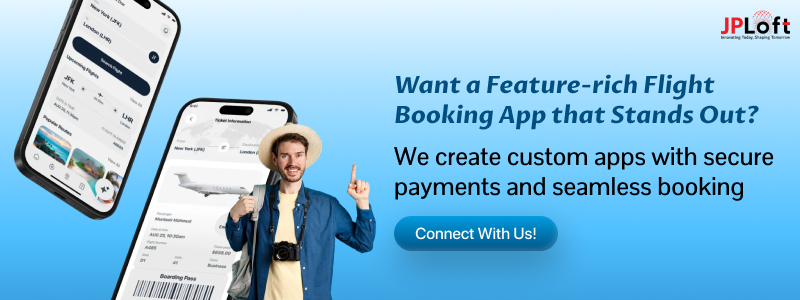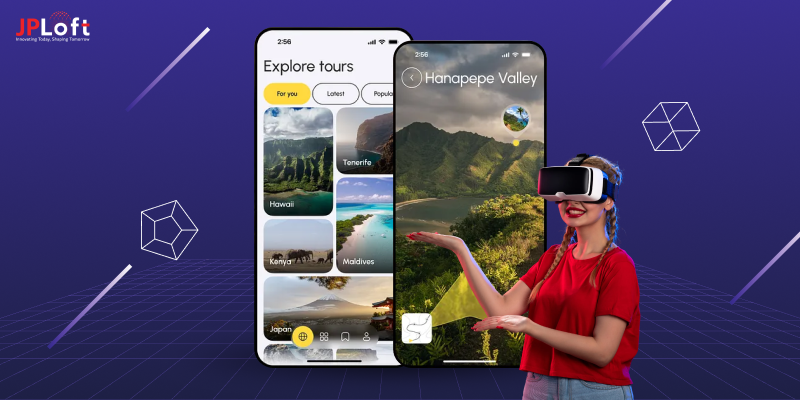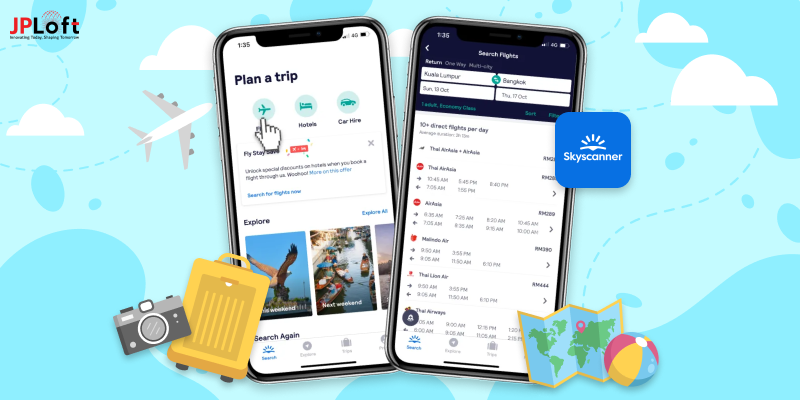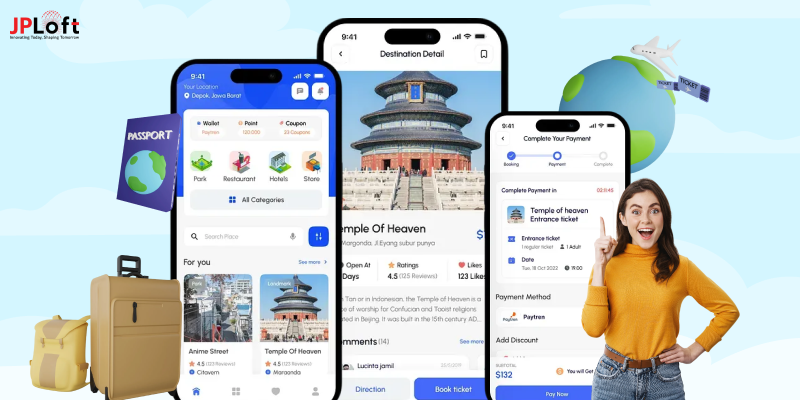Key Takeaways
Flight booking apps are no longer optional; they are a necessity for travel businesses to meet customer expectations for speed, convenience, and real-time updates.
Understanding the process to develop a flight booking app, including defining features, designing UI/UX, integrating APIs, and testing, helps entrepreneurs streamline development and build scalable, error-free solutions.
Success depends on combining essential features like flight search, secure payments, and notifications with advanced elements such as AI-powered personalization and multilingual support.
Estimating custom flight booking app development cost early is essential. Costs range from $40,000 for a basic MVP to $150,000+ for a feature-rich, enterprise-level platform.
Partnering with an experienced team like JPLoft ensures reliable development, innovative solutions, and ongoing support for long-term growth.
The travel industry has shifted dramatically in recent years. Last year, over 850 million people used a travel app to plan their trips, highlighting the shift towards mobile-first solutions.
This change has fueled the rise of flight booking apps, making them a cornerstone of modern travel experiences.
For entrepreneurs and businesses, the question isn’t if they should invest in one, but how to create a flight booking app.
They can start with defining the app’s core features, such as real-time flight search, booking management, secure payments, and notifications, then move to UI/UX design, backend development, and third-party API integrations for airlines and payment gateways. Testing and compliance checks ensure reliability before launch.
The global travel app market reached a size of over $1 trillion in 2024 and is projected to grow at a compound annual growth rate (CAGR) of 9.2%, reaching $242.4 billion by 2030.
A well-designed platform not only enhances customer convenience but also opens doors to new revenue streams and market opportunities.
This guide gives you knowledge about how to develop a flight booking app. We’ll break down everything you need to know, from features and development processes to cost factors and monetization strategies.
What is a Flight Booking App: A Clear Definition
A flight booking app is a digital platform that enables users to search, compare, and book airline tickets directly from their smartphones or other devices.
Travelers increasingly prefer the best travel apps for instant confirmations, personalized deals, and seamless payment options, rather than relying on traditional websites or travel agents.
From an industry perspective, flight booking app development has become an essential part of the digital travel ecosystem.
These apps often integrate multiple services such as flight status updates, seat selection, baggage tracking, and loyalty program management, making them far more than simple ticketing tools.
For businesses exploring how to build a flight booking app, the goal is not just to replicate existing services but to create a platform that enhances user trust and convenience.
A successful solution combines a user-friendly interface, secure transactions, and value-added features like push notifications for price alerts or AI-driven suggestions for the best routes.
Modern travelers expect apps with smooth navigation, intuitive layouts, and appealing visuals. Planning, prototyping, and iterative testing ensure the app is both reliable and engaging.
For startups and enterprises, it’s often the first major step when they decide to create a mobile app tailored for the travel industry.
Ultimately, a flight booking app is more than just a booking tool; it’s a gateway to improved customer satisfaction, stronger brand presence, and long-term revenue opportunities.Flight Booking App Market in 2025: Key Insights
The flight booking app market has grown exponentially in recent years, driven by increasing smartphone penetration, digital payments, and travelers’ preference for instant, on-the-go solutions.
Today, over 350 million users worldwide rely on mobile platforms to compare fares, manage bookings, and receive real-time updates on flights, making flight booking apps a cornerstone of the travel ecosystem.
-
Market Size and Forecast: The global online airline booking platform market is projected to reach USD 243.6 billion in 2025, with mobile apps contributing to more than 54% of total bookings. Analysts predict a CAGR of 18.5% through 2030, highlighting the lucrative opportunity for startups and enterprises looking to invest in travel tech.
-
AR Innovations: Technologies like AR in travel apps are reshaping the user experience, allowing travelers to visualize seating arrangements, airport layouts, and immersive previews of destinations before booking. Such interactive features not only enhance engagement but also reduce booking errors and increase customer satisfaction.
-
Revenue Streams: Flight booking apps benefit from multiple monetization avenues, including commissions on bookings, premium subscriptions, and targeted offers. Integrating AI-driven personalization further boosts revenue by recommending flights, packages, and deals tailored to individual preferences.
-
Industry Insights: Staying informed about travel app development trends is essential to create competitive platforms. Emerging practices include AI-based fare predictions, loyalty program integrations, dynamic notifications, and scalable backend architectures. Companies that combine innovation, seamless UI/UX design, and cutting-edge technology are best positioned to capture market share and cultivate loyal customers in a highly competitive landscape.
By leveraging modern technology, user-centric design, and strategic planning, businesses can build flight booking apps that not only meet traveler expectations but also unlock long-term growth in the thriving travel sector.
Why Make a Flight Booking App?
Creating a flight booking app empowers your business to reach travelers directly, simplify booking processes, and deliver personalized experiences.
It also helps companies unlock new revenue streams and strengthen brand loyalty in a highly competitive market.
1. Tap Into the Growing Mobile Travel Market
With millions of travelers now booking flights via smartphones, mobile-first platforms have become indispensable.
A dedicated app allows businesses to engage users instantly, provide real-time flight updates, and deliver a seamless booking experience.
By investing in a flight booking app today, companies ensure they stay relevant as digital adoption in the travel industry accelerates.
Mobile apps also help brands build a stronger presence in the competitive travel ecosystem, giving them a direct channel to reach tech-savvy travelers and boost overall engagement.
2. Offer Personalized Travel Experiences
Modern travelers expect more than simple ticketing. Flight booking apps can analyze user preferences, search history, and location data to deliver tailored recommendations.
Features inspired by Tripadvisor app development allow users to discover flights, destinations, and travel packages suited to their tastes, making planning more enjoyable.
Personalization increases user engagement and loyalty, encouraging repeat bookings.
Integrating AI-based suggestions and curated offers ensures travelers feel understood, positioning your app as a trusted companion in their journey rather than just a transactional platform.
3. Streamline Operations and Reduce Costs
A flight booking app automates reservations, cancellations, and notifications, minimizing manual work and human errors.
Centralizing operations improves efficiency and allows staff to focus on strategic tasks instead of routine processes.
Notifications, reminders, and automated confirmations ensure a consistent experience across all users, reducing operational friction.
Over time, this streamlined workflow lowers costs while enhancing service reliability, making your business more agile and better equipped to handle high volumes of bookings efficiently.
4. Unlock New Revenue Streams
Apps offer multiple monetization avenues, from commissions on bookings to premium features and partnerships with airlines or travel agencies.
By leveraging effective mobile app monetization strategies, businesses can integrate itinerary management, loyalty programs, and value-added services to boost revenue.
In-app promotions, bundled travel packages, and targeted offers allow companies to diversify income sources while providing meaningful value to users.
A well-structured monetization plan ensures the app not only serves travelers but also contributes significantly to the business's bottom line.
5. Strengthen Brand Presence and Customer Loyalty
A thoughtfully designed app positions your brand as modern, tech-savvy, and customer-focused.
Smooth navigation, intuitive layouts, and personalized services enhance user satisfaction and encourage repeat engagement.
Features such as destination discovery, multi-city itineraries, and easy travel planning help companies deliver a richer and more convenient user experience.
By consistently providing a seamless, engaging platform, companies can retain existing users, attract new ones, and reinforce brand trust, building a loyal customer base over time.
How Does a Flight Booking App Work: Step-by-Step Overview
A flight booking app simplifies the entire travel planning process, guiding users from flight search to final confirmation with seamless interactions.
By integrating smart features and real-time updates, these apps enhance convenience, engagement, and trust.
Step 1: User Search and Flight Discovery
The process begins when a user searches for flights by entering travel details such as origin, destination, dates, and passenger count.
Advanced apps leverage smart algorithms to provide real-time flight options.
Understanding the process to create a flight booking app involves building efficient search engines that pull data from multiple airline APIs to display accurate and up-to-date results.
Step 2: Comparing Options and Filtering
Once search results appear, users can filter by price, duration, airline, or stops. Modern apps prioritize user experience, ensuring filters are intuitive and easy to navigate.
During the planning phase, developers carefully structure these screens to provide seamless navigation and help users quickly find the best options.
Step 3: Selecting Flights and Seats
After filtering, users select a preferred flight and choose their seats. Some apps display seat maps or allow upgrades.
During development, testing these interactions early helps ensure a smooth booking flow, minimizing drop-offs and abandoned searches while enhancing overall user experience.
Step 4: Payment and Confirmation
Secure payment gateways are integrated to handle multiple payment methods, from credit/debit cards to digital wallets.
Real-time confirmation and ticket generation are critical for user trust. This stage must be designed carefully to ensure scalability, security, and support for multiple currencies.
Step 5: Notifications and Updates
Flight booking apps often provide push notifications for booking confirmation, flight reminders, delays, or gate changes.
These features enhance user convenience and engagement, keeping travelers informed and encouraging repeat usage.
Step 6: Additional Services and Loyalty Programs
Many apps include extras like baggage tracking, travel insurance, and loyalty rewards.
These value-added features differentiate your app and can be part of a long-term flight booking app development guide, ensuring your platform stays competitive and appealing in a crowded travel app market.
Features to Include in a Flight Booking App
A successful flight booking app combines convenience, speed, and personalization through essential features that meet modern travelers’ expectations.
Including the right functionalities ensures smooth navigation, enhanced engagement, and higher booking rates.
Let’s get to know different features of the flight booking app:
1. User-Friendly Search and Filters
A seamless search experience is the backbone of any flight booking app. Users should be able to input origin, destination, dates, and passenger details quickly.
Advanced filtering options, such as price, duration, stops, and airline, help travelers find the best options. Prioritizing top travel app features ensures your platform is both intuitive and efficient.
2. Real-Time Flight Information
Integrating real-time data from multiple airlines allows users to view up-to-date schedules, delays, and cancellations.
Accurate and instant updates enhance trust and usability, a critical aspect when planning the flight booking app development process.
3. Secure and Versatile Payment Options
Offering multiple payment gateways, including credit/debit cards, UPI, and digital wallets, is essential for any flight booking app.
A robust payment system ensures smooth, reliable transactions and builds user trust.
Implementing strong travel app security measures helps protect sensitive information and ensures compliance with data protection regulations, giving users confidence in every booking.
4. Personalized Recommendations and Offers
Custom suggestions based on user history, preferences, or loyalty programs enhance engagement.
Advanced recommendation engines can suggest the best flights, nearby airports, or bundled deals, improving the user experience and increasing booking rates.
5. Booking Management and Notifications
Users should easily manage bookings, view tickets, cancel or reschedule flights, and receive push notifications for confirmations, gate changes, or delays.
Ensuring these features work flawlessly is part of how to develop a custom flight booking app.
6. Reviews, Ratings, and Loyalty Programs
In-app reviews and ratings guide users in choosing airlines or specific flights.
Integrating loyalty programs incentivizes repeat bookings, strengthening user retention and overall app success.
7. Multi-Language and Multi-Currency Support
Catering to global travelers requires support for different languages and currencies. This enhances accessibility and makes your app appealing to international users.
8. Intuitive UI/UX Design
A clean, responsive, and visually appealing interface is crucial. Focusing on how to design a travel app ensures smooth navigation, faster load times, and a pleasant user experience, encouraging repeat engagement.
How to Create a Flight Booking App?
Building a flight booking app requires careful planning, the right tech stack, and seamless integrations with airline APIs.
This section explores the essential steps to build a flight booking app that delivers convenience, security, and scalability.
Step 1: Define Your App Concept and Target Audience
Before diving into development, the first step in how to create a flight booking app is to define the core idea and identify your target audience. A clear concept helps shape features, design, and marketing strategy.
► Understand User Needs
Analyze what travelers expect: budget options, flexible schedules, or luxury travel. A solid process to develop a flight booking app starts with addressing user pain points.
► Identify Business Goals
Decide whether your app will generate revenue through commissions, subscriptions, or ads. Business clarity ensures every development step aligns with long-term objectives.
► Research Use Cases
Explore real-life booking scenarios, such as solo travelers, families, or business trips. These insights guide the guide to make an AI-powered flight booking app that resonates with different customer segments.
► Competitive Benchmarking
Study competitors to find gaps in their offerings. A complete guide to build a flight booking app includes learning from others’ strengths and weaknesses.
Step 2: Market Research and Competitor Analysis
Thorough research ensures you position your app effectively. Without it, even the best features can fail to attract users.
► Analyze Industry Trends
Stay updated with market demand, seasonal booking patterns, and global travel adoption. Leveraging insights is part of how to build a flight booking app.
► Competitor Feature Mapping
Compare top apps for unique features. If you’re planning how to create a travel app, note what differentiates leading platforms from smaller players.
► User Reviews Study
Examine reviews of existing apps to identify common complaints like slow updates or limited filters. Addressing these gaps strengthens your product.
► Market Positioning
Determine where your app fits: budget-friendly, premium, or niche. Proper positioning ensures better visibility in the crowded app marketplace.
Step 3: Wireframing and UI/UX Design
Design sets the foundation for usability. A clean interface ensures smooth navigation. Following the process to develop an AI-powered flight booking app ensures every user touchpoint is seamless.
► Wireframing the Flow
Sketch the app’s structure, from search to payment.
Incorporating mobile app wireframing and prototyping at this stage helps visualize layouts, test user interactions, refine features, and ensure smooth navigation.
This step in the process to develop a flight booking app ensures smooth navigation.
► Focus on User-Centric Design
Build with the traveler in mind. Easy access to filters, flexible calendars, and seat maps enhances engagement.
► Mobile-First Approach
Since most users book via phones, responsive design is essential. Collaborating with the best mobile app development company helps achieve a sleek mobile-first experience.
► Visual Consistency
Maintain consistent colors, fonts, and layouts across the app. This builds trust and reduces cognitive load for users.
Step 4: Choosing the Right Tech Stack
Your mobile app tech stack defines how well the app performs under heavy traffic and API loads.
► Backend Development
Select a scalable backend to handle thousands of users. Stability here is central to build an AI-powered flight booking app.
► API Integrations
Integrate Global Distribution Systems (GDS) or airline APIs for real-time flight data. These integrations are key to reliable service.
► Database and Cloud Hosting
Secure and scalable databases ensure smooth operations. Cloud services reduce downtime while managing surges in traffic.
► Cross-Platform Support
Support both Android and iOS users from the start. Working with an on-demand app development company simplifies cross-platform execution.
Step 5: Development and Integration
This step turns planning into a working product, from writing code to integrating third-party services.
► Core Features Build
Start with search, booking, and payment as core features. Additional modules can be added later.
► Third-Party Services
Integrate maps, payment gateways, and email notifications to improve functionality. These integrations add value to the process to develop a flight booking app.
► Agile Development
Use agile methodology to release updates in phases. This reduces risk and ensures faster feedback.
► Scalability Testing
Ensure your system can handle peak holiday bookings. Scalability is central to the complete guide to building a flight booking app.
Step 6: Payment Gateway and Security Features
Users trust your app with sensitive data. Security should never be compromised.
► Multiple Payment Options
Support cards, UPI, wallets, and net banking. This improves accessibility across diverse user groups.
► Encryption Standards
Implement advanced encryption to safeguard payment details. Trust plays a major role in repeat bookings.
► Compliance with Regulations
Follow industry compliance, such as PCI-DSS. Staying compliant is part of how to build a flight booking app securely.
► Fraud Detection
Add AI in cybersecurity to prevent misuse and maintain credibility.
Step 7: Testing, Launch, and Maintenance
The final steps involve testing the app, deploying it, and then moving on to ongoing maintenance once deployment is complete.
► Quality Assurance
Run functional, performance, and usability tests. This helps avoid errors that frustrate users.
► Beta Testing
Release to a small group for real feedback. This validates design choices before the official launch.
► Launch Strategy
Plan a phased rollout with promotions to maximize adoption. Partnering with experts who hire dedicated developers can accelerate a smoother launch.
► Ongoing Maintenance
Post-launch, fix bugs, update APIs, and add new features. App maintenance services are an important part, if you create an AI-powered flight booking app for ensuring long-term success.
Can AI be Useful in Creating a Flight Booking App?
AI is transforming how travel apps interact with users, personalize experiences, and optimize operations. Integrating AI can make your flight booking app smarter, faster, and more customer-friendly.
Here’s how:
1] Personalized Flight Recommendations
AI analyzes user behavior, preferences, and past searches to suggest flights tailored to individual travelers.
For example, a business traveler may receive options for the shortest travel times, while a budget traveler sees the cheapest fares.
Leveraging AI in hospitality ensures higher engagement and improved conversion rates.
2] Dynamic Pricing and Fare Prediction
Machine learning models can predict flight price fluctuations, helping users book at the most optimal time.
This feature not only enhances user satisfaction but also increases trust in your app’s reliability.
Implementing AI-driven fare predictions is part of how to build an AI trip planner app strategy that many leading travel platforms are adopting.
3] Smart Chatbots for Customer Support
AI chatbots handle booking queries, cancellations, refunds, and FAQs 24/7.
They reduce dependency on human agents, provide instant responses, and improve customer experience.
Integrating such tools is essential in the process of developing a flight booking app today.
4] Intelligent Notifications and Alerts
AI can trigger personalized push notifications for price drops, flight delays, gate changes, or loyalty rewards.
Users feel informed and valued, which encourages repeated bookings. Apps that leverage AI-driven alerts not only enhance convenience but also improve overall customer satisfaction and trust.
5] Enhanced Data Insights and Analytics
AI tools track user interactions, booking patterns, and feedback to provide actionable insights.
These analytics guide business decisions, marketing campaigns, and feature prioritization.
Partnering with AI app development services can streamline the integration of these capabilities efficiently.
Integrating AI into a flight booking app doesn’t just improve functionality; it creates a highly personalized, predictive, and efficient experience that modern travelers expect.
By leveraging AI features like smart recommendations, dynamic pricing, chatbots, intelligent alerts, and analytics, businesses can build apps that stand out in a competitive market while maximizing user engagement and revenue potential.
Top Flight Booking Apps In the Market: Get Inspired
The flight booking app market in 2025 is more competitive and innovative than ever. Travelers now expect apps that are not only fast and reliable but also intuitive, personalized, and all-in-one solutions for managing trips.
By exploring the top apps in the industry, entrepreneurs and developers can gather insights and inspiration for building their own successful platforms.
1. Kayak
Kayak is a comprehensive flight booking platform known for its intuitive interface and powerful search filters.
Users can compare flight prices across multiple airlines, set fare alerts, and manage itineraries all in one place. Its mobile app integrates hotel and car booking, making it a complete travel companion.
Entrepreneurs looking to enter the travel tech space often explore how to develop an app like Kayak, focusing on features like multi-source search, real-time pricing, and personalized recommendations to replicate its user-friendly experience and robust travel ecosystem.
2. Hopper
Hopper stands out for its predictive analytics, helping users find the best time to book flights. By analyzing historical data, the app predicts fare changes and sends alerts when prices drop. Hopper also enables hotel bookings and travel packages, streamlining the planning process.
For businesses aiming to replicate this model, learning how to create an app like Hopper involves integrating AI-driven price predictions, push notifications, and a sleek mobile interface to deliver a seamless and highly personalized experience to users.
3. Expedia
Expedia offers a one-stop solution for booking flights, hotels, rental cars, and vacation packages. Its app provides detailed itineraries, travel alerts, and loyalty rewards, enhancing the overall travel experience.
To create a similar platform, developers often explore how to develop an app like Expedia, emphasizing real-time availability, multi-channel bookings, and a user-centric design that ensures travelers can seamlessly manage all aspects of their journey from a single interface.
4. Skyscanner
Skyscanner is a global flight aggregator that simplifies fare comparison across airlines and travel agencies.
Its features include flexible search options, fare alerts, and mobile-friendly booking flows. Its intuitive interface and fast search make planning trips easy for users, while developers can draw inspiration for creating apps that combine convenience and efficiency.
5. Google Flights
Google Flights is known for its speed, reliability, and advanced search capabilities. Travelers can filter flights by duration, airline, stops, and price trends. Its intuitive interface makes exploring destinations and comparing fares seamless.
Developers looking to enter this space should focus on integrating AI suggestions, historical pricing analysis, and location-based services to replicate the convenience that Google Flights provides, helping users make informed booking decisions quickly.
6. TripIt
TripIt is a travel organization app that excels in itinerary management.
By consolidating flight, hotel, and car rental information into a single, easy-to-access interface, it simplifies trip planning for frequent travelers.
Users can forward confirmation emails, and TripIt automatically creates organized itineraries.
Developers looking to replicate this model can explore how to develop a travel planner app like TripIt, focusing on features such as calendar integration, real-time updates, and AI-based recommendations to make trip planning seamless and efficient for travelers.
Studying these top-flight booking apps reveals the power of intuitive design, predictive analytics, and personalized experiences in shaping successful travel platforms.
Whether you aim to create a multi-service app or a specialized travel planner, drawing inspiration from these industry leaders can help you build an engaging and reliable solution that travelers love.
Custom Flight Booking App Development Cost
Understanding the custom flight booking app development cost is crucial for businesses planning to enter the travel tech space.
On average, the cost to build a successful flight booking app ranges from $40,000 for a basic MVP to $150,000+ for an advanced, enterprise-level platform with AI-driven recommendations, loyalty programs, and multi-currency support.
For startups, a basic MVP version covering core booking, payment, and confirmation flows generally falls between $40,000–$60,000.
Mid-level apps with stronger UI/UX, real-time updates, and personalization features typically cost $70,000–$100,000.
At the high end, feature-rich solutions with advanced integrations can exceed $120,000–$150,000, depending on scale.
Flight Booking App Development Cost Breakdown
|
App Type |
Estimated Cost Range |
Details |
|
MVP (Basic) |
$40,000 – $60,000 |
Core booking, payments, confirmations |
|
Mid-Level |
$70,000 – $100,000 |
Better UI/UX, real-time updates, personalization |
|
Advanced |
$120,000 – $150,000+ |
AI features, loyalty programs, multi-currency, and enterprise-level scalability |
Location also plays a major role in pricing. Hiring developers in the U.S. or Europe may cost nearly double compared to outsourcing to skilled teams in Asia.
Many businesses benchmark these numbers by comparing the cost to develop a travel app, which often overlaps with flight booking projects due to shared features like search engines, APIs, and payment systems.
Design quality is another cost driver, as premium UI/UX investments can significantly influence the overall budget and user adoption.
When budgeting, it’s also important to remember that expenses don’t end at launch; ongoing maintenance, updates, and scalability planning should be factored in for long-term success.
All in all, the cost to create an AI-powered flight booking app varies widely but usually sits between $40,000 and $150,000+, depending on complexity, region, and long-term strategy.
Factors Impacting the Overall Cost to Create a Flight Booking App
The cost of developing a flight booking app isn’t fixed; it varies depending on several critical factors. Understanding these helps businesses plan budgets effectively and set realistic expectations.
► Choice of Development Partner
The expertise and location of your development team significantly affect costs.
Collaborating with a specialized mobile app development company in the UK often ensures high-quality standards and advanced technical expertise, though it may come with a higher price compared to outsourcing elsewhere.
► App Features and Complexity
The scope of features directly influences pricing.
A basic version with flight search and booking will cost far less than an advanced solution with AI-driven personalization, fare prediction, loyalty programs, and chatbot support.
Businesses must prioritize core features first and add complex ones in later updates to manage expenses better.
► Integrations and Third-Party APIs
Flight booking apps require seamless integration with global distribution systems (GDS), payment gateways, real-time flight trackers, and customer loyalty systems. Each integration adds development hours, increasing costs.
Selecting the right APIs early on ensures smooth performance and reduces the need for expensive rework.
► Ongoing Support and Updates
Many businesses underestimate the importance of post-launch costs.
Regular updates, bug fixes, and performance enhancements are necessary to maintain reliability and competitiveness.
Partnering with providers offering mobile app maintenance services is essential for long-term success and to avoid unexpected downtime.
► Development Team Location and Scale
Geographic location affects hourly rates, while team size influences timelines.
Choosing the right combination of location and skilled professionals can help businesses balance cost, quality, and project efficiency, ensuring timely delivery without compromising on expertise.
The overall cost to develop an AI-powered flight booking app depends on a mix of factors, such as team expertise, app complexity, integrations, and long-term support.
By carefully evaluating these elements and choosing the right partners, businesses can develop an app that fits both their budget and market goals.
How to Make Money From a Flight Booking App?
Creating a flight booking app isn’t just about convenience for travelers; it’s also about generating sustainable revenue.
Here are the most effective travel app monetization strategies to consider:
A] Commission on Bookings
Most flight booking apps make money by charging airlines or travel agencies a commission fee for each booking made through the platform. This model ensures consistent revenue, especially when the app gains a large user base.
B] Advertising Partnerships
Apps can partner with hotels, travel agencies, or tourism companies to display targeted ads. By offering personalized promotions, you not only increase ad revenue but also improve user engagement by presenting relevant deals.
C] Subscription Plans
Premium subscriptions can give users access to added benefits such as fare predictions, exclusive discounts, or ad-free browsing. Frequent flyers, in particular, find value in paid plans, making this a recurring revenue stream.
D] Data Insights and Analytics
Aggregated user data (while keeping privacy intact) can be sold to airlines or agencies for market insights. This allows businesses to better predict demand and adjust pricing strategies, creating another revenue source.
Flight booking apps can be monetized through multiple avenues, from commissions and ads to premium services and AI-driven personalization. The key is to balance user satisfaction with innovative revenue streams, ensuring the app stays profitable and competitive in the long run.
Challenges to Build a Flight Booking App
Building a flight booking app is exciting, but it comes with its share of challenges.
Understanding these obstacles early helps businesses plan effectively and create a successful app.
1. Complex API Integrations
Problem: Flight booking apps rely heavily on Global Distribution Systems (GDS), airline APIs, and payment gateways. Integrating these systems can be technically challenging and time-consuming.
Solution: Partnering with experienced developers and using robust API documentation can simplify integration. Addressing travel app development challenges early ensures smoother app performance and reliable bookings.
2. Ensuring Payment Security
Problem: Handling sensitive user data and transactions increases the risk of fraud and breaches. Weak security measures can lead to loss of trust and legal issues.
Solution: Implement advanced encryption, PCI-DSS compliance, and fraud detection systems. Secure payment processing reassures users and strengthens app credibility.
3. High Competition in the Market
Problem: The travel app industry is saturated, making it difficult for new apps to gain visibility and users. Without differentiation, apps may struggle to attract bookings.
Solution: Focus on unique value propositions like personalized recommendations, loyalty programs, or innovative AI features. Studying why online travel apps fail can help you avoid common pitfalls and stand out.
4. Maintaining Real-Time Data Accuracy
Problem: Flight schedules, seat availability, and pricing change frequently. Any delays or inaccuracies can frustrate users and result in cancellations.
Solution: Use reliable APIs and real-time data syncing. Frequent testing ensures your app always provides accurate and updated information, improving user satisfaction.
5. User Retention and Engagement
Problem: Even after a successful launch, keeping users engaged is challenging. Poor experience or lack of value-added features can lead to churn.
Solution: Implement personalized offers, notifications, and loyalty incentives. Observing top-flight applications can provide insights into engaging and retaining users effectively.
6. Regulatory Compliance
Problem: Travel apps must comply with international regulations, including data privacy laws and payment standards. Non-compliance can lead to fines or legal action.
Solution: Consult legal experts and integrate compliance protocols from the start. This reduces risks and ensures smooth global operations.
While creating a flight booking app involves multiple challenges from API integration to user retention, careful planning, security measures, and innovative features can turn these obstacles into opportunities. Addressing these challenges proactively ensures your app stands out in a competitive market and delivers an exceptional user experience.
Partner with JPLoft and Build a Flight Booking App
Building a successful flight booking app requires expertise, experience, and the right team. At JPLoft, we specialize in developing custom, user-friendly, and feature-rich travel apps that cater to both travelers and businesses.
From concept and UI/UX design to development, testing, and deployment, our team ensures every step aligns with your goals. By partnering with a trusted travel app development company, you can leverage cutting-edge technology, including AI integrations and real-time booking systems, to deliver a seamless experience.
Let JPLoft help you transform your travel app idea into a fully functional, revenue-generating platform that stands out in today’s competitive market.
Conclusion
Learning how to create a flight booking app in today’s competitive market offers immense opportunities for businesses and entrepreneurs. By following a structured development process and focusing on features that enhance user experience, companies can deliver a seamless and engaging platform.
Integrating AI, ensuring secure payment systems, and addressing development challenges strategically ensure the app stands out.
Understanding the cost to make an AI-powered flight booking app and planning monetization avenues effectively can lead to sustainable revenue growth.
Whether building a simple MVP or a feature-rich platform, this complete guide to building a flight booking app equips businesses with the knowledge to launch a successful travel solution in 2025.
FAQs
Start by defining your concept and audience, then design a user-friendly UI/UX. Integrate airline APIs for real-time data, add core features like flight search, bookings, and secure payments, and enhance with AI-driven personalization. Finally, test thoroughly, launch, and keep updating the app for smooth performance and scalability.
The timeline depends on the app’s complexity, features, and development team. A basic MVP can take 3–4 months, while a full-featured, AI-integrated app may require 6–9 months or more. Proper planning and phased development help streamline the process.
Core features include flight search and filters, booking and ticket management, secure payment gateways, notifications, and user accounts. Advanced features may include AI-driven recommendations, fare predictions, loyalty programs, and real-time flight updates.
Yes, AI can enhance personalization, automate customer support with chatbots, predict fare changes, and provide smart notifications. Integrating AI improves user engagement, increases bookings, and makes the app more competitive.
Costs vary based on features, design, integrations, and the development team. A basic app may start around $40,000–$50,000, while a complex, feature-rich solution can exceed $120,000–$150,000. Proper budgeting ensures quality without overspending.
Revenue can come from commissions, advertising, premium subscriptions, ancillary services like hotel bookings or insurance, and AI-driven personalization. Choosing the right monetization strategy is key to profitability.
Focus on unique features, seamless UI/UX, real-time data accuracy, secure payments, and AI-driven personalization. Competitive research and continuous updates are essential to maintain an edge.













Share this blog